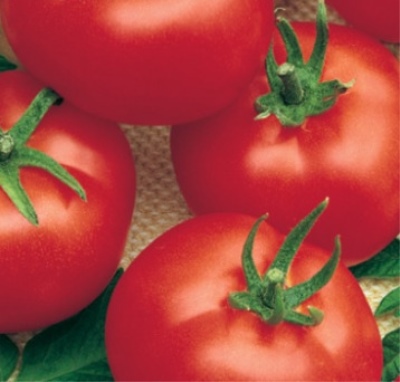
- Authors: SeDeK
- Category: grade
- Growth type: determinant
- Appointment: fresh consumption, for juice
- Ripening period: early
- Ripening time, days: 87-95
- Growing conditions: for open ground, for film greenhouses
- Bush size: undersized
- Bush height, cm: 60-80
- Bush characteristic: bushy
Iceberg is a tomato that lives up to its name. This culture was bred specifically for cold regions. It will be an excellent choice for summer residents who have tried many varieties in search of a variety that can successfully bear fruit in an unfavorable climate.
Description of the variety
Iceberg was bred by the Russian company CeDeK, which since 1995 has been specializing in the production of high-quality varieties of different crops. The variety belongs to the determinant variety, and its fruits are successfully used for making juice, pasta, ketchup. They are happy to eat them fresh.
Iceberg is a low-growing variety, the height of the bush is only 60-80 cm. The variety is bushy, but its branching is average. The described variety has the following undeniable advantages:
does not need a garter;
perfectly withstands cold and other adverse conditions;
suitable for different types of workpieces;
can be transported for sale;
has a good keeping quality.
The cons are as follows:
resistance to diseases and pests leaves much to be desired;
outdoors, the yield will be less than in a greenhouse.
The main qualities of the fruit
The iceberg produces large red tomatoes weighing up to 200 grams. The shape of tomatoes is flat-round, but there are also specimens that resemble a bag in shape. The pulp is dense and fleshy. Each fruit contains quite a few seeds.
Taste characteristics
The taste was rated as excellent. The fruits have a classic tomato flavor, they are juicy and sweet.
Ripening and fruiting
Iceberg is an early variety. The full ripening period will take 87-95 days. The first fruits, with proper agricultural technology, appear already in July.
Yield
The variety has a high yield. About 4 kilograms of tomatoes are harvested from the bush. A square meter of the greenhouse will bring about 30 kilograms of fruit to the gardener.
The timing of planting seedlings and planting in the ground
Low-growing types of tomatoes are not recommended to be sown too early. The date of planting for seedlings is chosen about 55 days before planting in the ground. Most often this is the end of March. Seedlings are sown in disinfected containers, while the air temperature should be at least +15 degrees. Maintenance will not be burdensome: spraying from a spray bottle, airing, covering with a film. At the end of May, the seedlings are transferred to a greenhouse or open ground. It is important that the warm weather is already stable.

Growing tomato seedlings is an extremely important process, because it largely depends on whether the gardener will be able to harvest at all. All aspects must be taken into account, from seedbed preparation to planting in the ground.
Landing scheme
The bushes are undersized, so up to 6 copies will grow quietly on 1 square meter. A distance of 30-40 cm is observed between the bushes, and it will be the same between the rows.

Growing and care
Caring for Iceberg tomatoes is not particularly difficult. An important step will be watering, which should be carried out as the soil dries up. One bush will require a liter of water. It is recommended to dispense liquid after sunset or in cloudy weather. Once every 14 days, the soil is loosened. It is important that no crust forms on the soil. If the tomatoes are growing on heavy soils, a deep loosening system is recommended for the first 14 days.
10 days after planting, the seedlings will need to be earthed. Before this, the soil must be watered. The next hilling is carried out after about 3 weeks.
The iceberg also needs fertilizers. This variety responds well to mullein slurry. Mineral complex compounds will also be useful. They should be brought in several times per season.
As for pinching, in the case of this variety, it is not necessary. The gardener decides for himself whether the plant needs it or not.




A plant needs different micronutrients at each stage of growth. All fertilizers can be divided into two groups: mineral and organic. Folk remedies are often used: iodine, yeast, bird droppings, eggshells.
It is important to observe the rate and period of feeding. This also applies to folk remedies and organic fertilizers.
Disease and pest resistance
The iceberg is quite often affected by diseases and pests. Of parasites, it can be attacked by a whitefly, a bear, a wireworm. You need to fight uninvited guests with insecticides, but not during fruiting or active ripening of fruits.
Diseases are mainly of fungal origin. In order not to have to use fungicides, maintain order on the site: water correctly, do not create excessive moisture, give top dressing, remove fallen leaves from the site.


Resistant to adverse weather conditions
The variety is very cold tolerant and is therefore actively cultivated in cold areas in late spring. He is not afraid of temperature changes either. However, watering will require regular watering.
Review overview
Summer residents are enthusiastic about the Iceberg tomato variety. Unpretentious care, large fleshy fruits, taste characteristics and resistance to bad weather conditions - all this makes gardeners very happy. However, many noted that the variety still has to be tied up sometimes. At times, too many tomatoes can ripen on one brush, although this is quite a rare occurrence.

























































































